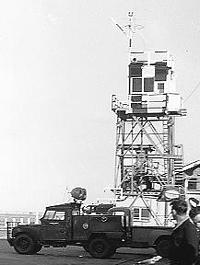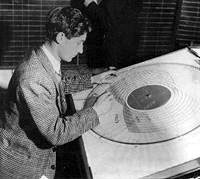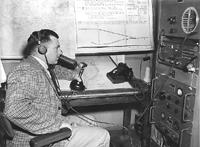
The enormous growth in air traffic in Australia has produced problems in regard
to the control of aircraft in order to ensure that their operations are conducted
in safety and with the regularity and precision which are essential in any well-organised
transport system.
The problems in handling air traffic differ from those applying to other transport methods due to the fact that aircraft are restricted to the use of one road (runway) for the take-off and landing, whereas railway and sea transport is usually routed to a number of roads (platforms or piers) at the terminals, while road traffic is even less restricted in this regard.
The
following paragraphs outline how order is achieved in the air transport field
in Australia.
To simplify the subject an ordinary flight by an airliner can be divided
into three parts: the departure and climb, the cruise, and the descent
and landing. Having agreed on the subdivision, it is no doubt pertinent
to inquire just how an aircraft is flown from place to place. Is it subjected
to a limited path and rules of the road as is the unfortunate motorist,
or has it the freedom of limitless sky, unfettered by rules to be obeyed?
The answer to that question is rather relieving. Rules of the air, and
the control that is exercised go much further than rules of the road.
Furthermore, air routes are just as carefully surveyed as are highways
and are almost as restricted. The difference, of course, lies in the fact
that an air route is some thousands of feet deep. However, just as on
the highways, the sign posts are there, sometimes in the form of radio
beams, sometimes as radio
beacons. The detours are also provided for, as will be seen later.
To sum up with a practical example, the route between Sydney and Melbourne
is a well-defined skyway and all aircraft flying between the two capitals
follow it. So now let us see how the traffic police prevent aircraft colliding.

It may be that the weather conditions at Melbourne are forecast to be
worse than certain specifications, in which case the pilot will be required
to carry additional fuel for flight to another
suitable aerodrome if Melbourne is closed on arrival. The Air Traffic
Control Officer will also specify the altitude at which the aircraft shall
fly.
In the matter of determining which altitude may be allotted to an aircraft, the consideration is that of ensuring an aircraft will be at least 1000 ft. above ground along the route. Secondly, an arbitrary rule is followed which provides an automatic separation of 1000 ft. between aircraft. To confine our attention to the congested Sydney-Melbourne route, it will be seen that aircraft flying in opposite directions must always be separated by at least one thousand feet, and aircraft flying in the same direction will either be separated by at least 2000 feet or will be at the same altitude.

To control
flights in this manner it is necessary that Air Traffic Control be frequently
informed of the exact position of an aircraft. The "signposts" spoken
of previously allow a pilot to determine his position, and this information is
transmitted by radio to an aeradio station, which, in turn, advises Air Traffic
Control. Any instructions from Air Traffic Control to an aircraft are transmitted
by the aeradio service to the aircraft concerned.
En route, therefore, the movements of aircraft are carefully followed by Air Traffic Control, so that no collision risk may arise. Changes of speed or altitude which may be desired by a pilot are not approved until it is certain that such a change will not bring two aircraft into dangerous proximity.
It will be remembered that a comment was made earlier to the effect that air routes are provided with detours. It sometimes happens that the weatherman predicts the worst weather in the book, along the normal route. In these cases, Air Traffic Control will authorise the pilots to adopt an alternative route which will take aircraft clear of the rough weather belt.
It is apparent by this time that we have dealt with the middle portion of a flight first. To return to a reasonable sequence, we can now examine firstly the departure, and secondly the arrival, portions of a flight.
At busy aerodromes a particular type of control must be provided to prevent aircraft operating on and around the aerodrome from colliding with each other. Arrivals and departures are blended into an orderly stream by Aerodrome Control. The Aerodrome Controller, overlooking the aerodrome and its approaches from a high tower, directs aircraft by radio telephone and, in the case of light aircraft not fitted with radio apparatus, with signalling lamps.
To consider a departure, a departing aircraft before leaving the tarmac area calls Aerodrome Control by radio telephone and requests permission to taxi. In granting such permission, the Controller nominates the runway to be used for take-off, describes the path the aircraft must follow to arrive at the end of the runway, and provides information such as wind speed and direction, obstructions to be avoided and so on. On arrival at the end of the runway, the pilot will test his engines and generally ensure that his aircraft is performing normally, after which he will request permission to take-off. If the runway is clear, and if no other aircraft is approaching to land, such permission will be granted. After take-off, when the Controller is satisfied that the aircraft will not conflict with others around the aerodrome, the pilot will be instructed to report his departure to the aeradio station through which any route instructions will be issued.
Departing aircraft are usually instructed to climb away from the aerodrome in a direction which diverges from the path followed by arriving aircraft, which are descending towards the aerodrome. The system ensures that there will be no conflict between climbing and descending aircraft.

It is the function of this officer to co-ordinate traffic on all the air
routes converging on the aerodrome. In weather conditions such that pilots
must fly by reference to blind-flying instruments, aircraft must make
instrument approaches to the
aerodrome. These instrument approaches take some time to complete, and
several aircraft may be arriving almost simultaneously. In these circumstances,
the Approach Controller allots each aircraft an altitude so that all aircraft
under his control are separated by at least 1000 feet. An aircraft may
arrive over the aerodrome at an altitude of, for example, 7,000 ft., there
being a number of aircraft below this with higher priorities for landing.
The pilot would fly his aircraft back and forth along the radio beam,
descending by 1000 ft. when so directed by Approach Control, as previous
aircraft completed their instrument approaches. In due course an aircraft
will be instructed by Approach Control to commence approach. This is commenced
from a particular altitude and from a particular point on the radio beam,
the point being identified by a ‘marker beacon’ which emits
a vertical signal cutting the beam. A steady descent from this point along
the beam will bring the aircraft through the clouds, heading towards the
aerodrome, which will be only two or three miles away. The pilot of the
aircraft will then contact the Aerodrome Control for landing instructions.
As a result of instructions issued by Aerodrome Control, the aircraft will join an orderly rectangular pattern around the aerodrome, this pattern having as one of its long sides the runway in use.
In due course the aircraft will be given permission to land, and, having landed, will be directed in its taxiing from the runway to the tarmac area.
The arrival of an aircraft may be considerably less complicated, in as much as weather conditions may be perfectly clear. On the other hand, greater complications may be encountered.
If weather conditions - height of cloud, visibility, or both - deteriorate below certain specifications, the aerodrome will be closed, and an aircraft will not be permitted to land, or even to make an attempt to land. In such a case arriving aircraft will be directed to proceed to another suitable aerodrome. On the basis of the weather forecast issued at the departure point, this circumstance would have been provided for. The result of such a diversion, of course, is that passengers find themselves on the ground at an aerodrome at which they have no desire to be. However, it is far better to spend a few hours at another aerodrome than to commence at the destination an instrument approach which, due to unfavourable weather, might end in disaster.
-oOo-
See also a 1956 Film Strip describing Air Traffic Control
Back to the
main Air Traffic Services
index
If
this page appears without a menu bar at top and left, click
here